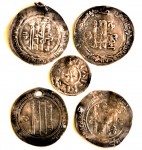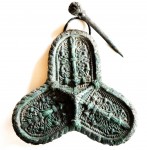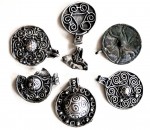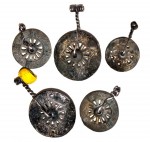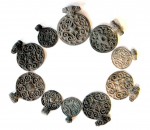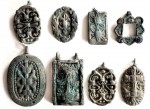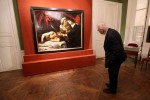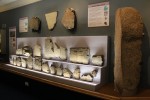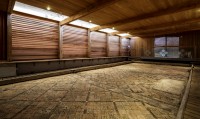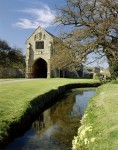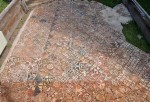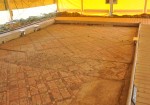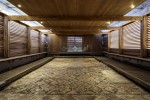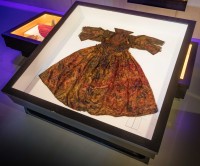 There are hundreds of shipwrecks buried under the sands of the Wadden Sea near the island of Texel off the coast of North Holland. A natural barrier between the North Sea and Wadden Sea, Texel was an important center of maritime trade. Ships anchored in the Texel roadstead, a sheltered area in the lee of the island, waiting for propitious winds, waiting out bad weather or taking on crew and cargo, only to be wrecked in sudden unexpected storms. Many wrecks are protected by the sand, but as currents shift they can be exposed to the more damaging elements of sea. Divers from the Texel Diving Club keep an eye on the condition of wrecks and recover artifacts that have been unburied and are in danger of destruction.
There are hundreds of shipwrecks buried under the sands of the Wadden Sea near the island of Texel off the coast of North Holland. A natural barrier between the North Sea and Wadden Sea, Texel was an important center of maritime trade. Ships anchored in the Texel roadstead, a sheltered area in the lee of the island, waiting for propitious winds, waiting out bad weather or taking on crew and cargo, only to be wrecked in sudden unexpected storms. Many wrecks are protected by the sand, but as currents shift they can be exposed to the more damaging elements of sea. Divers from the Texel Diving Club keep an eye on the condition of wrecks and recover artifacts that have been unburied and are in danger of destruction.
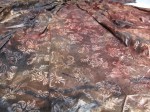 In August of 2014, divers discovered that artifacts from one known wreck, a well-armed merchant ship buried since it sank in the 17th century, had been exposed. They didn’t know what the objects were at first. It was just a bundle in the sand. It was only when the brought the bundle to the surface that they realized they’d recovered antique textiles. The find was not announced to protect the site from interlopers while conservators examined and stabilized the finds.
In August of 2014, divers discovered that artifacts from one known wreck, a well-armed merchant ship buried since it sank in the 17th century, had been exposed. They didn’t know what the objects were at first. It was just a bundle in the sand. It was only when the brought the bundle to the surface that they realized they’d recovered antique textiles. The find was not announced to protect the site from interlopers while conservators examined and stabilized the finds.
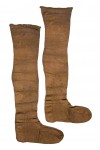 Conservators discovered that the bundle included a unique survival in exceptional condition: a silk damask gown of such high quality that it must have belonged to a noblewoman of very high rank, perhaps even royalty. Buried under the seabed for 400 years or so, the delicate silk was spared the ravages of both oxygen and animals. The dress has a bodice with loose-fitting sleeves and sleeve caps and a full pleated skirt open in the front. The neck has an upright collar. The style is of a type seen in paintings from the early 17th century.
Conservators discovered that the bundle included a unique survival in exceptional condition: a silk damask gown of such high quality that it must have belonged to a noblewoman of very high rank, perhaps even royalty. Buried under the seabed for 400 years or so, the delicate silk was spared the ravages of both oxygen and animals. The dress has a bodice with loose-fitting sleeves and sleeve caps and a full pleated skirt open in the front. The neck has an upright collar. The style is of a type seen in paintings from the early 17th century.
 The dress is just one element of an extensive wardrobe that includes a jacket, silk knee socks and silk bodices woven with gold and silver thread. All of these pieces are the same size, so archaeologists believe the clothes belonged to one full-figured woman. Only the gown shows signs of significant wear, which suggests it was intended for everyday use, as does the lack of rich silver and gold embroidery seen in the bodices.
The dress is just one element of an extensive wardrobe that includes a jacket, silk knee socks and silk bodices woven with gold and silver thread. All of these pieces are the same size, so archaeologists believe the clothes belonged to one full-figured woman. Only the gown shows signs of significant wear, which suggests it was intended for everyday use, as does the lack of rich silver and gold embroidery seen in the bodices.
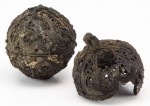 The dress has been examined by experts from the Rijksmuseum, the University of Amsterdam and the State Service for Cultural Heritage (RCE), all of whom agree that it is one of the important textile finds ever made in Europe. Professor Emmy de Groot of the University of Amsterdam called it “the Night Watch of the costume world.”
The dress has been examined by experts from the Rijksmuseum, the University of Amsterdam and the State Service for Cultural Heritage (RCE), all of whom agree that it is one of the important textile finds ever made in Europe. Professor Emmy de Groot of the University of Amsterdam called it “the Night Watch of the costume world.”
 Other artifacts were recovered from the wreck site. There’s Italian pottery, a silver gilt vessel, a red velvet pouch embroidered with silver thread that contained a two-sided lice comb made of cow horn, pomanders (openwork spheres that held sweet-smelling flowers or herbs for elegant people to sniff when the environment was particularly rank), and a number of leather book covers in different sizes, some with locks. One of them is stamped in gold with the coat of arms of King Charles I, which suggests at least part of the cargo was Stuart property. Perhaps the lady with the very fine wardrobe was a member of the Stuart family.
Other artifacts were recovered from the wreck site. There’s Italian pottery, a silver gilt vessel, a red velvet pouch embroidered with silver thread that contained a two-sided lice comb made of cow horn, pomanders (openwork spheres that held sweet-smelling flowers or herbs for elegant people to sniff when the environment was particularly rank), and a number of leather book covers in different sizes, some with locks. One of them is stamped in gold with the coat of arms of King Charles I, which suggests at least part of the cargo was Stuart property. Perhaps the lady with the very fine wardrobe was a member of the Stuart family.
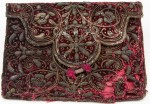 In addition to the passenger belongings, the ship’s cargo was remarkably varied. In addition to the wardrobe and expensive personal belongings, the ship was carrying boxwood — a dense, fine-grained wood widely used for musical instruments, chess sets and decorative carving — mastic from the Greek island of Chios, crates archaeologists believe held frankincense or myrrh, tobacco and aniseed. These objects found at the same time in the same context make the find a priceless historical time capsule that sheds new light on trade, politics and how people lived and worked on ships in the 17th century.
In addition to the passenger belongings, the ship’s cargo was remarkably varied. In addition to the wardrobe and expensive personal belongings, the ship was carrying boxwood — a dense, fine-grained wood widely used for musical instruments, chess sets and decorative carving — mastic from the Greek island of Chios, crates archaeologists believe held frankincense or myrrh, tobacco and aniseed. These objects found at the same time in the same context make the find a priceless historical time capsule that sheds new light on trade, politics and how people lived and worked on ships in the 17th century.
 The gown and other treasures are now on display at the Kaap Skil Museum on Texel. The finds belong to the Province of North Holland. After the month-long exhibition ends on May 16th, the artifacts from the wreck will be further studied and conserved at North Holland’s Huis van Hilde archaeology center. Once the research is complete, the Kaap Skil Museum will display the finds in a permanent exhibition.
The gown and other treasures are now on display at the Kaap Skil Museum on Texel. The finds belong to the Province of North Holland. After the month-long exhibition ends on May 16th, the artifacts from the wreck will be further studied and conserved at North Holland’s Huis van Hilde archaeology center. Once the research is complete, the Kaap Skil Museum will display the finds in a permanent exhibition.
UPDATE: The likely owner of the gown has been identified.



